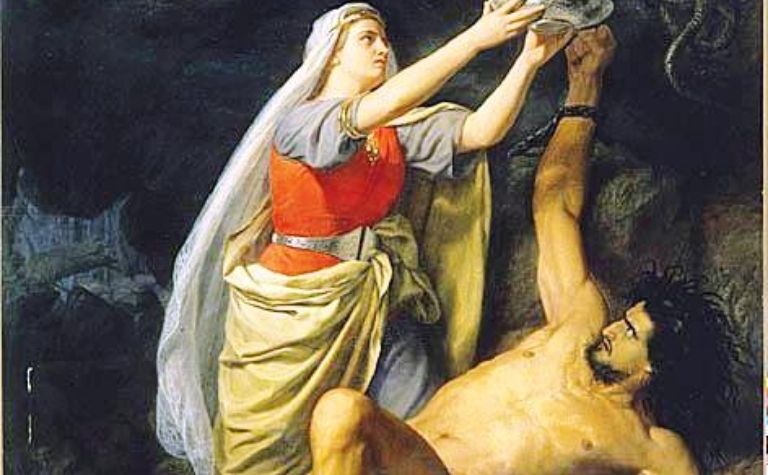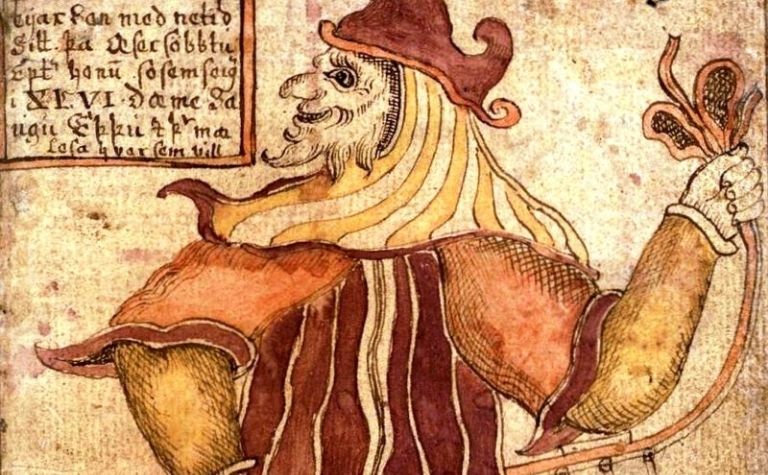Anyone who’s watched any of the Thor or Avengers movies released by Marvel in the past decade will probably recognize the trickster god Loki’s horned helmet.
But how true to form is the depiction of Loki in the Marvel films and comics? Did he even have horns or a horned helmet in Norse mythology?
Loki didn’t have horns or wear a horned helmet in the original Norse myths.
Instead, he was described in a way that makes him sound like a “normal” being who most might even consider handsome.
There are surviving stone carvings of Loki that show him with horns, but those aren’t true to the myths.
This article will further explore the topic of Loki and horns, and it will touch on what Loki looks like both in Norse mythology and the Marvel movies.
Finally, it will shed some light on whether or not Norse people wore the horned helmets they’re so often portrayed wearing.
Also, see Are Thor and Loki Brothers in Norse Mythology? to learn more.

Depictions of a Horned Loki
Although there are enough remaining sources of the original Norse myths to give scholars today an idea of what Norse people believed about their gods hundreds of years ago, there’s a lot that scholars don’t know.
Everything known about the Norse myths comes primarily from two main sources: The Prose Edda and The Poetic Edda, and unfortunately, sections are missing from those. [1]
Anything else people know about Norse mythology comes from heavily watered-down, Christian-authored sources and is likely not like the tales Norse people originally told.
For example, nothing in the Norse myths claims Loki has horns.
However, one of the few surviving carvings of Loki, alternately called the Loki Stone, the Kirkby Stone, Loki in Chains, or the Bound Devil, features Loki with large, curving horns – similar to those of a ram – sprouting from the sides of his head. [2]
The 10th-century stone resides at Kirkby Stephen Church in Cumbria and is one of only two stones of its kind in all of Europe.
Scholars believe that the artist added the horns on Loki to better equate the trickster god, who wasn’t evil in Norse mythology, to the Christian version of Satan.
It’s interesting to note that in other surviving depictions of Loki, such as on the Gosforth Cross and the Snaptun Stone, he does not have horns, although the Gosforth Cross does depict him in the role of the devil. [3]
Any depictions, descriptions, or mentions of Loki with horns, as a devil, or as evil were likely inventions by the Christians to try to make him fit more easily with their narrower view of good and evil.
Also, see 25 Norse Gods to Know to learn more.

What Does Loki Look Like in Norse Mythology?
Little is mentioned about Loki’s appearance in Norse mythology, though the Gylfaginning does say that he is long, thin, handsome, and fair to behold.
Some scholars believe that “fair” means he is blonde or red-haired, but others argue that “fair” means he is handsome.
Loki also has distinctive scarring around his lips. He earned his nickname “Scarlip” from a story in the Eddas where he loses a bet, and as punishment, the dwarves to whom he lost the bet sew his lips shut. [4]
Loki rips out the cord holding his lips together, leaving behind a nasty scar.
Of course, Loki is also a shapeshifter, so what he looks like can change from one moment to the next.
Various Norse myths talk about Loki changing his shape – into a fish, a mare, a fly/gnat, etc.
In his “normal” form, though, Loki looks much like a human and a handsome one at that.
What Does Loki Look Like in Marvel Movies?
In the Marvel movies, Tom Hiddleston portrays the character of Loki, so the character’s appearance is largely influenced by the actor who plays him. [5]
In most Marvel films, Loki has shoulder-length black, wavy hair, greenish-blue (sometimes fully green) eyes, and is tall and lean.
He also has an incredibly mischievous smile that’s instantly recognizable to any Marvel fan who sees it. He dresses primarily in green and has a golden, horned helmet.
Once Disney+ premiered Loki, the television show, Loki’s look started to change a bit, with his hair getting shorter and his wardrobe becoming more varied.
Plus, there are several new Loki looks if you begin factoring in all the Loki variants that pop up in the show.
This video showcases several of these different versions of the god of chaos:
Also see Norse Gods vs Greek Gods: Similarities and Differences to learn more.
If one were to factor those variants into the equation – as well as all the shapeshifting Loki does in the films – Loki’s appearance could be just about anything.
Did Norse People Wear Helmets With Horns?
It’s unlikely that Norse people or Vikings wore helmets with horns on them. They did often wear helmets into battle, but it would’ve been very impractical for those helmets to have horns.
This stereotype stemmed from 1800s art, in which artists included horned helmets in their paintings of raiders. [6]
In reality, horned helmets would have presented all kinds of problems for Norse warriors. For example, they would catch on things like bushes and tree limbs and make stealthy sneaking impossible.
They’d also provide additional handholds for the warriors’ opponents to grab onto while they were fighting.
The horns would have also added more weight to the already cumbersome helmets, and additional weight isn’t something any warrior wants to deal with when marching or fighting.
According to scattered fragments of helmets found throughout burial and other dig sites and from the one intact Viking helmet ever found – the Gjermundbu helmet – Viking helmets most likely covered the eyes and the top of the head. [7]
They were probably made of iron and resembled peaked caps.
The eyepieces were likely shaped like oversized glasses, leaving ample free space for the warriors to see around them when in battle. The bridge of the nose was almost certainly covered, as well.
Either way, they did not have horns.
Conclusion
Although early Christian stone carvings and the Marvel films depict Loki with horns, the Norse myths tell a different story.
Also, see What is the Valkyrie Symbol in Norse Mythology? to learn more.
References:
[1] Source
[2] Source
[3] Source
[4] Source
[5] Source
[6] Source
[7] Source
